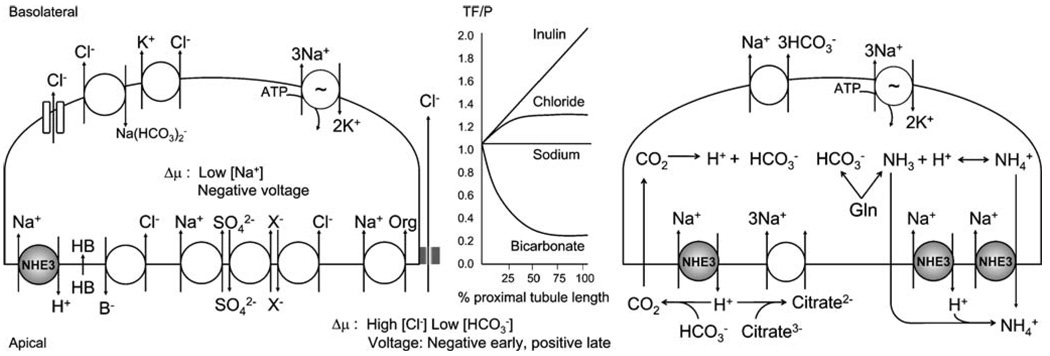Fig. 1.
Model of how apical Na+/H+ exchange mediates NaCl absorption (left) and luminal acidification (right). The electrochemical driving force (Δμ) is the low cell [Na+] and negative interior voltage generated by the Na+/K+-ATPase. The apical Na+/H+ exchanger NHE3 is highlighted in gray. Coupling of Na+/H+ exchange with Cl−/base (B−) exchange and acid (HB) recycling or triple coupling of Na+-sulfate cotransport, sulfate–anion (X−) exchange and Cl−/anion exchange constitutes net apical NaCl entry. The Na+ that enters with organic solutes (Org) also results in net NaCl entry when coupled to paracellular Cl− transport. Basolateral transcellular Cl− exit is achieved via diverse mechanisms (Cl− channel, Na+-dependent Cl−HCO3− exchange, and KCl cotransport). Luminal acidification by NHE3 titrates filtered HCO3− which results in HCO3− absorption. As luminal [HCO3−] falls with isotonic fluid absorption, luminal Cl− is concentrated (graph in middle panel) along the length of the proximal tubule, which enhances the Δμ for paracellular Cl− diffusion (TF–P, tubular fluid to plasma concentration ratio). The H+ extruded by NHE3 also titrate filtered trivalent citrate to bivalent citrate, which is taken up by the Na+-citrate cotransporter. Citrate reabsorption is tantamount to base equivalent absorption. The metabolism of neutral glutamine (Gln) generates NH4+ (acid) and HCO3− (base). NH4+ secretion is mediated by NHE3 either by luminal trapping of diffused NH3 or by NH4+ traversing as a substrate. Base exit is mediated by the Na+-HCO3− cotransporter

